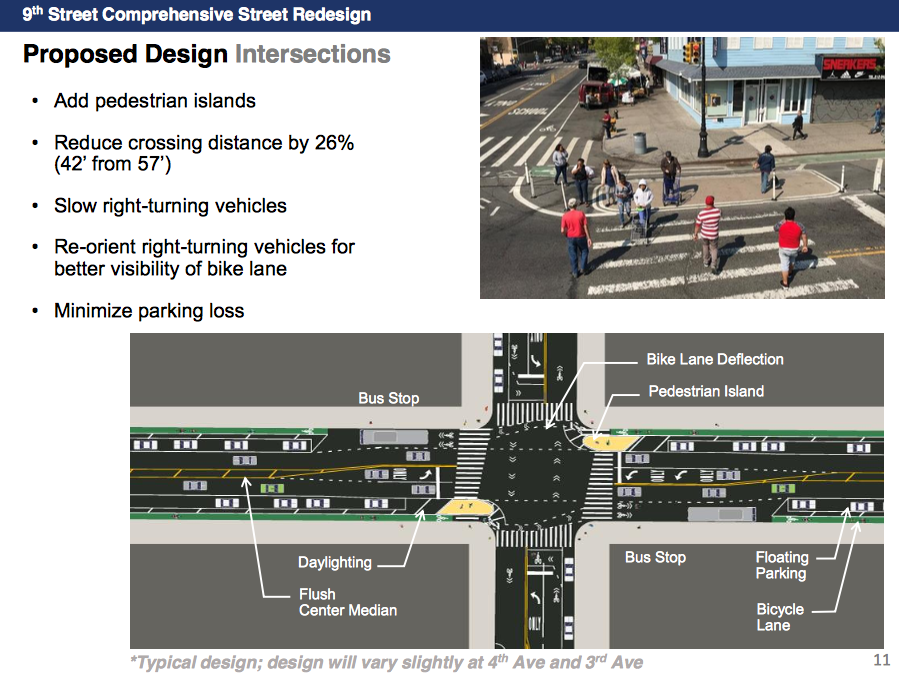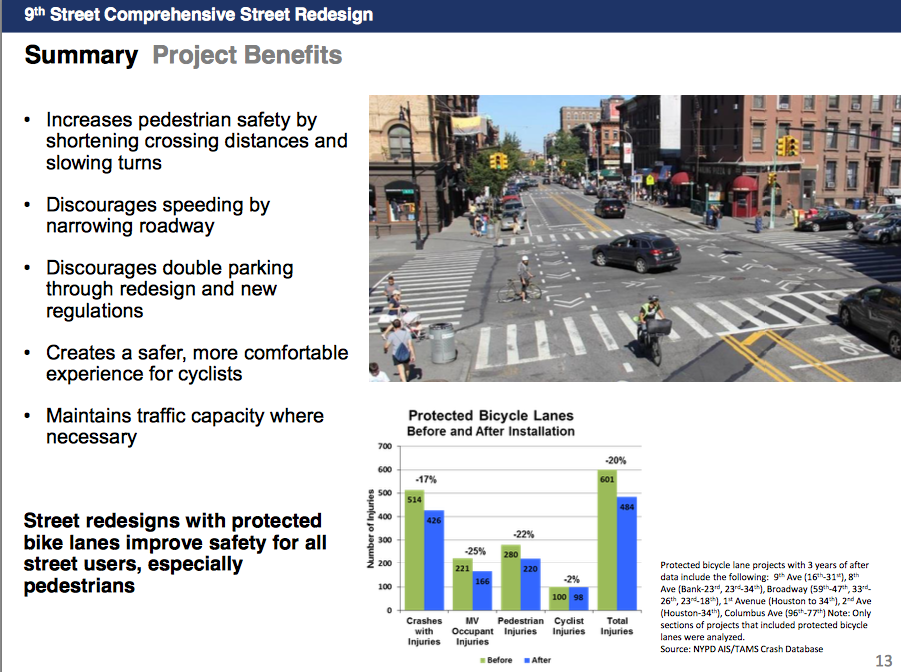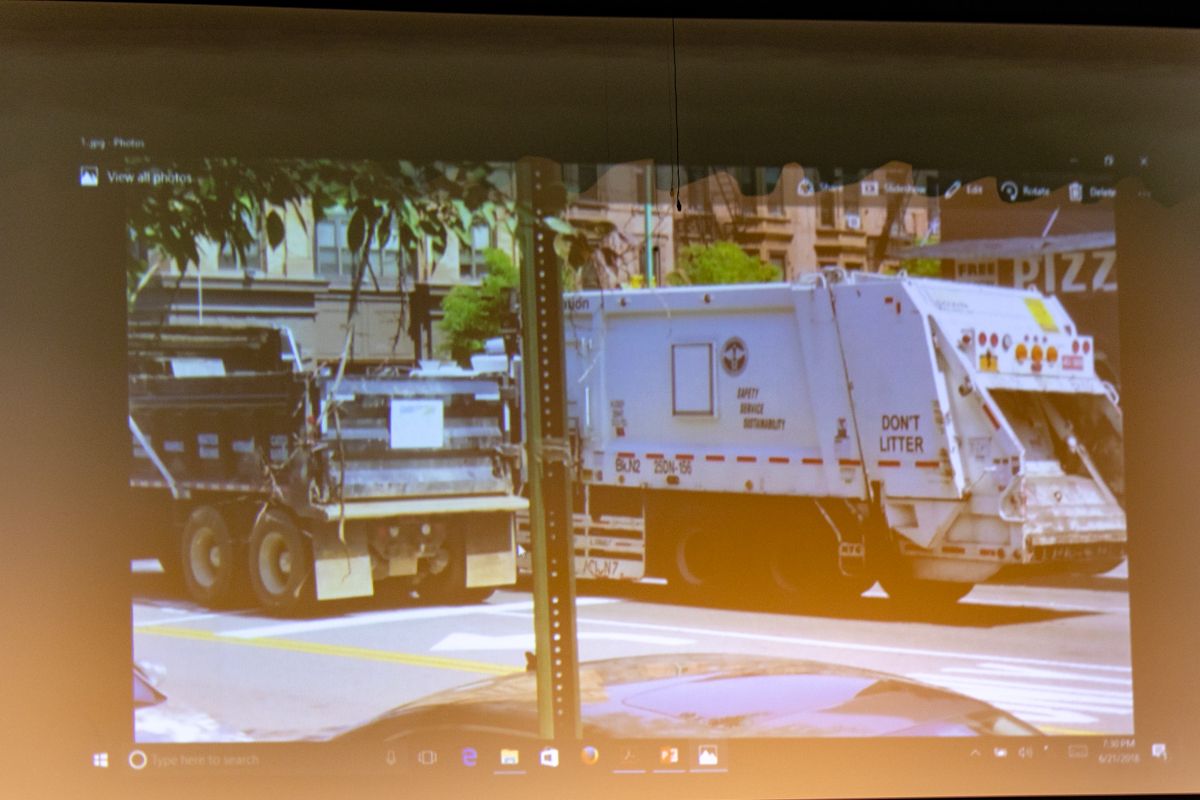9th Street Redesign: A Step Closer To Reality

PARK SLOPE – The Brooklyn Community Board 6 Transportation Committee unanimously voted to approve the NYC Department of Transportation‘s (DOT) redesign of 9th Street (between 3rd Avenue & Prospect Park West) Thursday evening with a few conditions.

At the end of May, DOT’s Ted Wright, the Director of the Bike Program, presented the agency’s preliminary 9th Street redesign at a town hall-style workshop held at MS 51 where locals came together to identify dangerous locations across the neighborhood following the fatal crash in March at 9th Street and 5th Avenue that took the lives of 4-year-old Abigail Bluemenstein and one-year-old Joshua Lew.
Wright returned Thursday evening to present the 9th Street Comprehensive Street Redesign to the community board and neighbors at the John Jay Educational Campus. “This is a safety project,” he started. “I want to emphasize I do work for the bike program but it’s not just for bikes.”
“We can’t solve for every crash, but what we can do is use the tools we see that have a substantive effect in other neighborhoods and bring them to your neighborhood and hopefully, if we get the context right—[and] that’s what we’re here today to talk to you guys about—we can then create a better street for everybody to use,” he continued.

DOT’s 9th Street redesign includes:
- Improvements to pedestrian safety by shortening the crossing distances and slowing down cars as they turn
- Improvements to bicyclist safety and comfort by reducing frequent double-parking in the bike lane
- Maintaining vehicle circulation by minimizing congestion and spillback onto other streets, reducing off-peak speeding, and allowing emergency access
- Minimizing parking loss by adding loading zones where needed
“What we’re doing is really quite simple,” Wright explained. “We’re taking that buffered bike lane—right now it’s on the outside of the parked cars—and we’re just flipping it across the parked cars and we’re putting a protected bike lane in between the parked cars and the curb. What this does, it does make it safer for bikes, but it [also] narrows the roadway considerably.”
“A lot of the real advantages that we see on the bike network narrow the roadway, puts cars in the right place, puts bikes in the right place,” he added. “It’s really one of the best ways we could use to calm traffic and get everybody out there on the street in the right place and make it safer for everybody.”
The new bike lane will measure 4 feet, the buffer will be 3 feet, the standard parking lane will be 8 feet, each traffic lane will be the standard 11 feet, and the median buffer will be increased to 5 feet which will accommodate emergency access vehicles and provide “a little bit of extra space in case somebody does double park.”

Islands will be installed on the corners to shorten the crossing length for pedestrians. “It is a fairly long crossing, 57 feet. That is pretty wide,” Wright noted.
The islands will also force cars to slow down and take wider turns, increasing visibility and allowing drivers to see approaching bicyclists. “You’re going to have actual islands that are going to tighten up the roadway at the most critical points,” he explained.
The addition of the islands will take away some parking spots. “We’re talking about a total of 26 spaces out of 310 on the corridor,” Wright said. “We have this broken down by block, it’s about [a] 4 or 5 per block loss to those islands.”

“Right now the bike lanes are not that useable because people use them for double-parking, that’s a problem for bikers but it’s also a problem for everybody,” Wright continued. “Double-parking makes the road less safe. It leads towards movement where people dip in and out of traffic and that is less safe.” DOT will put loading zones in front of commercial businesses where both cars and trucks most frequently double-park.
“We’re going to expand curb access for loading zones,” he explained. “We’re working with our parking group and we’re going to make sure that all the loading zones are the right size for the amount of double-parking that we see out there right now.” The agency is already studying the situations in front of the post office, the McDonald’s, CVS, YMCA, grocery stores, and a car service dispatch, and welcomes suggestions from the public on other areas along 9th Street to consider for potential loading zones.
“We’re also looking at hardening the center line along the street,” Wright added. “That means on the double yellow center line on 9th we’re going to have yellow sticks that stop people from cutting off. You won’t be able to leave your lane until you get to the actual intersection.”

Following Wright’s concise presentation, the floor was opened up for questions and comments from the community. Many expressed concerns about truck drivers traveling on 9th Avenue, which is not a truck route, and double-parking whether to make deliveries or to stop and have lunch.
Wright said by narrowing the roadway, some truck drivers, though he admitted maybe not all, “will no longer feel comfortable double-parking” on that corridor. Many in the audience balked, saying they’ll still do it.

Wright added that his team has had discussions with the Freight Group at DOT and promised they will “come back and have a serious conversation” with the community board. “You pointed out a very big hole in our truck route—it is very hard to get down to the IBZs in Red Hook and Sunset Park…because of banned turns on 3rd Avenue and banned turns on 4th Avenue (both avenues are truck routes). We’re going to talk with them about it,” he promised.
A lifelong resident of 9th Street said he didn’t think the redesign solved the street’s problems. “You did the math and you came up short as far as getting around a double-parked car…because people don’t park within 6 inches of each other,” he noted. “Double-parking is a real problem.”
“Basically, I believe the bikers are the winners in this plan,” he continued, an opinion shared by others at the meeting. “There’s no doubt there’s going to be double-parking on 9th Street. Smiling Pizzeria—half the neighborhood stops to get a pizza on Friday night and they double-park. This plan doesn’t solve anything. It helps the bikers.”
“It helps everyone. Statistically it’s a fact,” Wright said to the unconvinced speaker.
“New York is about the most unfriendly city for pedestrians,” said Ian, a Park Slope resident. “Drivers in this city treat us like we’re just targets. I don’t bicycle on 9th Street because you can’t get to the bike lane. It’s just double-parked, it’s blocked.”
“I don’t go to businesses on 9th Street, I don’t go to businesses on Atlantic Avenue. Why? Because those are unsafe places. I can’t walk down there and feel good about crossing the street,” he continued.
“I have no doubt this is a better plan than what we’ve got today,” he said. “It makes things safer, it makes some of the crossing safer. I can’t believe that there’s no consideration for the traffic on 5th Avenue. There’s nothing to slow the cars if they make their turns. My biggest fear at that intersection is cars on 5th Avenue turning onto 9th Street because they can do that very rapidly.”
Wright insisted that the redesigned narrower lanes on 9th Street will significantly slow down cars as they make that turn from 5th Avenue.
At the start of his presentation, Wright explained that DOT uses traffic signals “on the roads that keep the vehicles moving, in this case it’s the avenue streets,” he said. “Meaning when you’re on 4the Avenue or 5th Avenue, you hit the lights, they keep you moving.”
“The crosstown streets (like 9th Street) do not have the most efficient signal configuration. It’s a little bit slower on 9th Street, so you can’t push through as many cars as you want.”
Some meeting attendees questioned why LPI (leading pedestrian intervals) signals were not part of the plan. “We have thought about LPIs, we have a little bit of an issue with LPIs. There are LPIs on north/south, but the east/west it’s much more difficult without causing spillback on these streets. It is something we’re looking at, but we don’t want to promise anything right now,” Wright said.
Several neighbors living on adjacent streets asked what consideration was given to their streets who will bear the brunt of the overflow traffic as well as cars circling their blocks for parking spaces. They were instructed to contact Keith Bray, DOT’s Brooklyn Borough Commissioner as well as Council Member Brad Lander with their concerns.

Kathy, a Park Slope parent, created an ideal redesign (complete with unicorns) with her four- and six-year-olds. “I would like to see more innovation,” she said. “Like marking crosswalks with art to make them stand out, putting planters on curb extensions to create a sense of a residential area.” She added she’d also like to see more curb extensions, delayed green lights, speed cameras, speed limit signs, raised crosswalks.
“I really think that 9th Street should be a model street for the rest of New York. I don’t think this [design] quite meets that and I think a lot more could be done,” she continued. “I would love to see more innovation and a model street because our neighborhood deserves that. Our children deserve that.”
At the close of the meeting the Transportation Committee voted unanimously to approve DOT’s 9th Street redesign with the motion to recommend the proposed plan be implemented as soon as possible with the following conditions:
- That DOT work within their own agency and other NYC agencies to curtail city truck volume on the 9th Street corridor
- The plan include the installation of truck route signage
- That DOT investigate the north/south streets with the goal to expand islands and safety features including raised intersection treatments
- That DOT consider bicycle signals on the corridor
- That DOT returns to address plans west of 3rd Avenue.
Prior to DOT’s presentation of the 9th Street Comprehensive Redesign, the CB6 Transportation Committee passed a motion to request that Governor Cuomo hold a special session to consider extending and expanding the Vision Zero School Zone Speed Camera Program which will expire at the end of July since the bill was not addressed before the end of the legislative session on Thursday.
Click here to see DOT’s full 9th Street Comprehensive Street Redesign Presentation.



